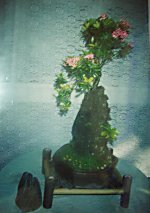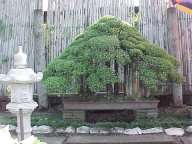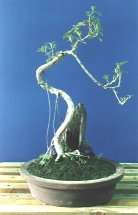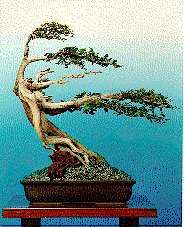



|
Bonsai in Asia Guide Book has moved you will be automatically redirected to http://www.bonsai-in-asia.com |
Bonsai in the Philippines

About Bonsai in the Philippines
The Philippine Bonsai Society Inc. (PBSI)
Other Bonsai & Suiseki Clubs in the Philippines
UPD Bonsai Garden - Quezon City
The Bonsai Garden of Mr Ceballos
How to make a Bonsai Bonsai Books History of Bonsai What is a Suiseki Useful Bonsai Links
Help me to add information to these pages
- Send me Email & CommentsThese Web Pages setup by John Oldland -
Sign Guestbook - View GuestbookMABUHAY - Welcome to Bonsai in the Philippines

Most of the trees used for Bonsai in the Philippines are local trees like Ficus, Kalyos (Streblus Asper),Orange Jasmin, (Muraya Paniculata), Philippine tea, Bantigue (Pemphis Acidula), Lantana, Tamarind, Camagong (Philippine Ebony), Camachile (Pithicolodium Dulce), Bignay, Yangya, Pyracantha, Bouganvilla, Lemoncito. Many of these are collected trees and trained as Bonsai
Although Bonsai (as we know it today) is a fairly new hobby in the Philippines there is some evidence to show that Chinese immigrants were growing Balete trees (a local term referring to ficus) onto corals in the 15th century. They would insert the roots into the coral's crevices and place them onto water basins until the roots clasped the host corals. The arrangement were small enough to be carried by one hand. The tree would in a certain time of the year be leafless as if dead, but only to shoot out new buds that symbolized the Resurrection of Easter Sunday. Since trade between the Philippines and China had been ongoing centuries before the Spaniards came, it would not be far-fetched to think that this art was already flourishing even before then. (Relacion de las Islas Pilipinas by Fr. Pedro Chirino, S.J. 1604)
The Philippine Bonsai Society Inc. (PBSI)- is the main club that represents the whole Philippines and meets on the first Saturday of every month at 2 pm at the Barangay Hall of Horseshoe Village, Sunset Drive, Quezon City, Philippines. The Philippine Bonsai Society also holds annual exhibitions; publishes a bonsai magazine twice a year that contains educational articles, pictorials, how-to-do and listings of plant for bonsai care; and a directory of reliable and legitimate bonsai artists and experts.
For more information you could Contact: The Secretariat PSBI, 2nd flr. Rose Bldg, West Ave, Quezon City, Philippines. Tel: 63-2-4123863 or 64. Fax: 63-2-3734087

Sagay City Bonsai Club, Inc
- Sagay City, Negros Occidental, Philippines.Mt. APO Bonsai Society - Davao - Island of Mindanao
The goal of the Mt. APO Bonsai Society is to develop an appreciation of the art of bonsai in the Island of Mindanao. We are headquartered in Davao and meet on the last Sunday of every Month.
For the meeting venue or more information please contact Rudy Cuba
PO Box 80422, Davao City 8000, Island of Mindanao, Ph/Fax: (6382) 235-1159 Email: rudycuba@yahoo.com
 -There is also a Bonsai club in Angeles City, Pampanga.
-There is also a Bonsai club in Angeles City, Pampanga.
Angono Bonsai Club
- there is also a Bonsai club in Angono, RizalPangasinan Bonsai Society
- headed by Michael MordenBaguio-Benguet Bonsai Group
- headed by Dr. Noel de LeonNorthern Luzon
- based in La Union and headed by Cliff ColomaLa Union Bonsai Society
- Bonsai Club in San Fernando CitySuiseki in the Philippines - Natural Stone Society
- Felicidad S Gupit is the President of the Natural Stone Society of the Philippines, which although a relatively young but dynamic organisation is dedicated to the awareness of natural stone collecting in a country rich with the splendor of rugged mountains and winding rivers. Those who are interested to join her, or invite her to speak about Suiseki, can call 721-7818 or 724-0429.If anyone can tell me more about any of these clubs I will add the information in (John O).

Bonsai Park - View some of Modi's Bonsai Trees
The Bonsai Park owned by Mr Modesto Manglicmot (Modi) has been relocated to the UPD’s Bonsai Garden.
UPD Bonsai Garden - University of the Philippines-Diliman, Quezon City
The Bonsai garden is a collection of over 200 bonsai trees donated by Modesto Manglicmot, former president of the Philippine Bonsai Society and the Philippine Horticultural Society.
Ninety-eight percent of the bonsai collection are Philippine species and more than 50 percent have won awards, with 25 pieces belonging to the top 10 winners in various Bonsai competitions, two Best Bonsai in Show and three as Best Plant in Show in the Philippine Horticultural Annual Exhibit.

The Bonsai Garden of Mr Ceballos - Caloocan City
Mr Ceballos has created a beautiful garden of sculptured topiary combined with Bonsai which is certainly worth looking at if you get the chance. The Bonsai garden is open to the public but those interested must contact Mr Ceballos first. If he is available, he will invite you to come and visit the garden.

The Bonsai Garden of Mr Ceballos is open to visitors by invitation only from sunrise to sunset, at 124 Bayanihan St Baesa, Caloocan City, Philippines.
Home Ph/fax # is 363 6977 and work office Ph # is 4266183 and fax 4331373.
Country and area codes are 63 2
Click on photo's to get a more detailed view
This article by coutesy of Mr Ceballos and Bonsai Clubs International.
Some pictures from the Megabonsai '99 in the Philipines - Abu Hassan

Froilan B. Samala - Pampanga
Click on this link to have a look at his Bonsai and Web page.

Kamuning Binangonan
- (Muraya exotica) This windswept Bonsai by Felicidad S. Gupit of The Philippines was entered into the BCI's annual Ben Oki International Design Award
Bonsai and Suiseki — Trees and Stones in Harmony- 1st Philippine Bonsai book published

TREE'S COMPANY - artificial Bonsai Trees
Artificial Bonsai - These Japanese artificial trees are done in silk polyester leaves on specially pruned trunks with foliage of Ming Aralia, Mini Maple Ivy, Mini Polycias Friuticose, and others, intricately arranged. Although I'm not keen on artificial Bonsai these look very good.
45 Libertad Street, Mandaluyong, Metro Manila, Philippines.
Maro Garden & Ornaments (Bonsai Hobby Center)
Naomi's Botanical Garden - province of Misamis Occidental - Western Mindanao.
Naomi's Botanical Garden is a 13-hectare farm, where ornamental plants, Bonsai, orchids, grafted fruits, seedlings, doves and ceramic products could be found.
The Defensor Sculpture & Bonsai Garden - Mandurriao, Iloilo City.
This garden consists of nine major sculptures in different media by Ed Defensor and some smaller sculptures by some members of Hubon Madiaas. These sculptures are distributed over a lawn area measuring close to a hectare. The Bonsai collection has been nurtured over a period of ten years & consists of over a hundred different varieties of Philippine plants & trees.
Located at: 33 Benedicto St. (Pali), Mandurriao, Iloilo City, three kilometers away from the Iloilo Airport Terminal
Carcar Bonsai Plants - Carcar 46km South of Cebu City
The town of Carcar is not only known for its famous shoe industry but is also into growing Bonsai plants. Bonsai was introduced to the Carcaranons by Fr Rudy Villanueva in 1975 and since then has become a thriving business. To get there just drive to Barrio Bolinawan where Sitio Bonsai can be located.
HDA. Luisa (La Castellana) - province of Negros Occidental.
Offers a breathtaking view of Kanlaon Volcano. Has collection of the best Philippine fruit trees, Bonsai plants, shells, rare animals and features a kidney-shape pool and cottages dominated by laminated shell walls and decor
Useful information about Bonsai and the Philippines
The Philippine climate is tropical climate tempered by constant sea breezes. There are three seasons, the rainy season (June to September), cool and dry (October to February), and hot and dry (March to May). The average daytime temperature range from 22C to 32C, and the average humidity is 77%. Typhoons occasionally occur between June and September.
The lonely Planet - Good online guide on the Philippines
Help me to add information to these pages
- Send me Email & CommentsThese Web Pages setup by John Oldland -
Sign Guestbook - View GuestbookAll Information and Photo's on these pages are COPYRIGHT and may not be reproduced without permission